
Quintino Sella mining engineer
Mattia Sella1
1Sezione Storia delle Geoscienze, Società Geologica Italiana.
Corresponding author e-mail: sellamattia@gmail.com
DOI: https://doi.org/10.3301/ROL.2024.18
Volume: 62/2024
Pages: 153-168
Abstract
University on 1847. The same year the Minister of Public Works, Luigi Des Ambrois, sent Quintino Sella and Felice Giordano to the École des mines in Paris. From 1850 Sella began to travel in Europe to visit various mining districts, before in central France, then in Germany, and in Erzgebirge (the Ore mountains). On December 1851 Sella was graduated élève breveté at the École des Mines. He was back in Turin on September 1852. In 1856 Sella became 2nd class engineer in the Royal Corps of Mining. 1860 represented a turning point for Sella who, elected to the Cossato (Biella) local council, started his political career and becomes promoter of science. On 1858 Sella and Giordano modified the mining laws of the Sardinian Kingdom which established the separation of underground from aboveground ownership. The same Decree created the Mining Council and Sella became a member. He was appointed Vice-President on 1866. On 1868 the Italian Parliament approved the Depretis Commission responsible for a parliamentary inquiry on Sardinia. Sella had been called to the commission because of his scientific expertise. The commission of inquiry on the conditions of the mining industry was sent to Sardinia in 1869. Eugenio Marchese and Sella undertook a tour of Sardinia to visit the mining areas. The same year Sella presented to Parliament the report On the conditions of the mining industry in the island of Sardinia. The Alberto della Marmora’s Carte géologique de l’île de Sardaigne was fundamental for the mining study of the island. In the report’s conclusions Sella, scientist and politician, listed a series of measures necessary for the development of the Sardinian mining industry. Between the more strategic proposals: the mining engineers should draw the large-scale geological map of Sardinia, with special attention to the mining situations. The first large-scale (1:50.000) geological and mining map, on the Iglesias area, was published on 1888; the second one, on the Sarrabus area, on 1889. On 1871, proposed by Sella, the School for Mining Foremen and Workshop Superintendents was established in Iglesias. Quntino Sella died on 1884. The Royal Corps of Mining, to remember Sella, posed a bronze plate in his grave, bearing in relief the hammers with the motto Gluck-Auf (good luck!), typical wish of German miners and which Sella always carried imprinted on his watch.
Keywords
Felice Giordano, large-scale geological maps, mining legislation, mining industry, Royal Corps of Mining, Sardinia mines.
Get Full Text